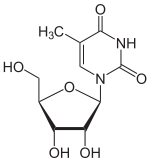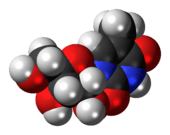5-Methyluridine
 | |
 | |
| Names | |
|---|---|
| IUPAC name
1-[(2R,3R,4S,5R)-3,4-dihydroxy-5-(hydroxymethyl)oxolan-2-yl]-5-methylpyrimidine-2,4-dione | |
| Other names
Ribothymidine, Ribosylthymine; Thymine riboside, m5u | |
| Identifiers | |
| 1463-10-1 | |
| 3D model (Jmol) | Interactive image |
| ChemSpider | 393058 |
| ECHA InfoCard | 100.014.522 |
| PubChem | 445408 |
| |
| |
| Properties | |
| C10H14N2O6 | |
| Molar mass | 258.23 g/mol |
| Melting point | 185 °C (365 °F; 458 K) |
| Except where otherwise noted, data are given for materials in their standard state (at 25 °C [77 °F], 100 kPa). | |
| | |
| Infobox references | |
The chemical compound 5-methyluridine, also called ribothymidine, is a pyrimidine nucleoside. It is the ribonucleoside counterpart to the deoxyribonucleoside thymidine, which lacks a hydroxyl group at the 2' position. 5-Methyluridine contains a thymine base joined to a ribose pentose sugar.
It exists in solid form as small white crystals or white crystalline powder, has a molecular weight of 258.23 u, and has a melting point of 185 °C. The stability of 5-methyluridine under standard temperature and pressure (STP) is very high.
References
This article is issued from Wikipedia - version of the 7/7/2015. The text is available under the Creative Commons Attribution/Share Alike but additional terms may apply for the media files.